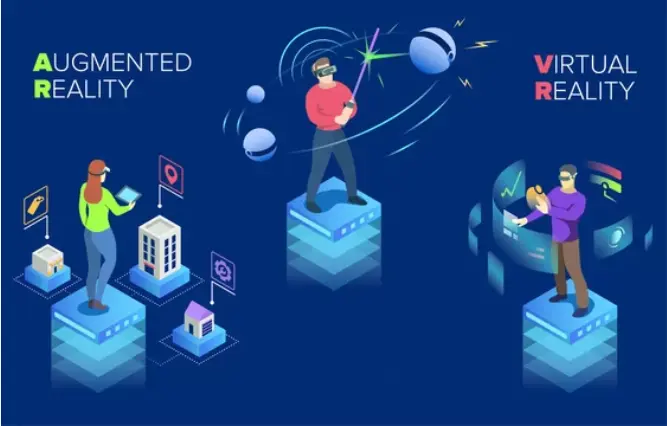The power of technology is diverse, including the types of services and solutions developers make out of it. Two unique technologies currently growing in popularity are Augmented Reality (AR) and Virtual Reality (VR).
Both AR/VR applications are helpful in different sectors, like electronics and IT, gaming, automobile, hospitality, and leisure. Besides these, the uses of AR and VR are visible in other avenues, like entertainment, brand development, marketing, and gaming.
Companies today are turning towards AR and VR technologies due to the high growth and profit potential. Statistically, 90% of companies with $100 million – $1 billion valuations use these technologies.

11 Differences Between Virtual Reality and Augmented Reality
Although most consider AR/VR app development in the same league, both have different uses and specifications. Therefore, before choosing one over the other, you should understand what each version offers.
What Is It?
VR: VR is mainly a computer-centric simulation of a different reality or world. Typically, it is utilized in 3D video games and movies and is a technology that mimics real-world objects and behavior with sensors and computers. Users essentially “immerse” into an alternate reality and carry out their movements in real-time, with real-world actions. It is commonly used in entertainment, games, education, science, and training.
AR: AR is a combination of real-life physical elements and digital technology to build an artificial world. Developers create different web-based and mobile-based applications to mix real-world and virtual components. Some notable examples of augmented reality technology are pop-out 3D images, messages, texts, and emails. Even the digital score overlays that appear on sports game screen boards run on AR technology.
Abbreviation
VR: VR stands for Virtual Reality.
AR: AR stands for Augmented Reality.
Basic Setup
VR:
● Users get a headset that comes with a screen in the two eye areas. Both the right and left eye displays showcase different images that influence the brain to see picture depth.
● Integrated motion sensors in the headset’s virtual reality software allow users to change background views as they turn their heads.
● Hand controls with motion sensors are available that allow players to hold, grab, or throw virtual objects within the VR environment.
● Tethered sets connect the power source and PC with the device, and they can link with sensors mounted on the wall to track users’ movements and mimic them in the game.
AR:
● The screen and computer are integrated with computer vision for surface and object identification.
● Motion and depth sensors allow the device to trace the game room and sense the movements of users.
● The AR application overlays the mapped sequence and motions with imagery for a first-person gaming perspective.
Immersion Level
VR: Here, the system controls all of the visual senses during the operation. Thus, you would get a fully immersed experience.
AR: Users know that they are in the real world; their visual sensors are not seeing the digital world. So, you would get a partial immersion into the action.
Real/Virtual ratio
VR: VR is 25% real and 75% virtual.
AR: AR is 75% real and 25% virtual.
Motion Sickness
VR: Users often feel motion sickness while using VR; however, this applies mainly to older headset models. Ones that refresh images fast do not give motion sickness, like Oculus Rift and HTC Vive, which run at 90 frames per second.
AR: Motion sickness does not occur with AR technology usage; there is no distortion in the perceived motion vs. real visual.
Mobility
VR: Phone-centric VR sets are not mobile in most cases; users have to turn their heads only. On the other hand, tethered VR systems allow mobility in more prominent areas but are not costlier.
AR: Since AR is mainly used on mobile phones directly, you would experience a more mobile experience. You can use this technology even while commuting. However, there are no headsets in AR examples which can make the experience less smooth.
Bandwidth
VR: Virtual reality technology requires around 50 Mbps bandwidth.
AR: Augmented reality technology needs approximately 100 Mbps bandwidth.
Number of Active Devices
VR: While using VR, you need to have multiple devices installed and activated to operate the VR environment.
AR: Users only require iPad and mobile phones to utilize the AR software.
Real-World Influence
VR: Whatever happens in the VR environment does not affect one in real life. Every scene that they notice is virtual imitations, i.e., fight sequences in action games.
AR: Since people are conscious and experience everything in the real world, they notice more real-time influences. This overall enhances the user experience of AR technology.
Emerging Cases
VR: Some areas where VR would increase operation include automotive prototyping, medical treatment, astronaut training, etc.
AR: Circumstances in which AR is used often, and would continue to develop, are wearable computing, interior design, and hands-on skill-based training.
Conclusion
Overall, Augmented Reality and Virtual Reality are not similar. However, they do run on a similar theme of combining virtual elements with real-world elements using technology.
VR is more immersive but can cost higher if you want to use the more extensive advanced sets. On the other hand, AR is user-friendly but does not give a fully immersed feel. Choosing one over the other depends on the preferences of users ultimately. So, consider this first.